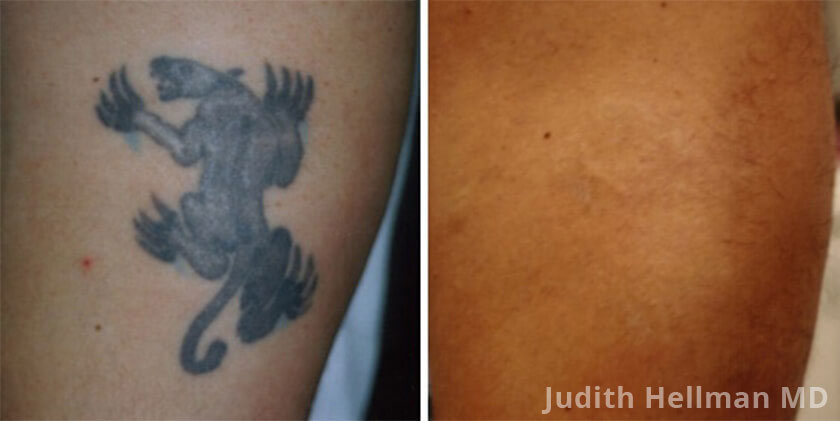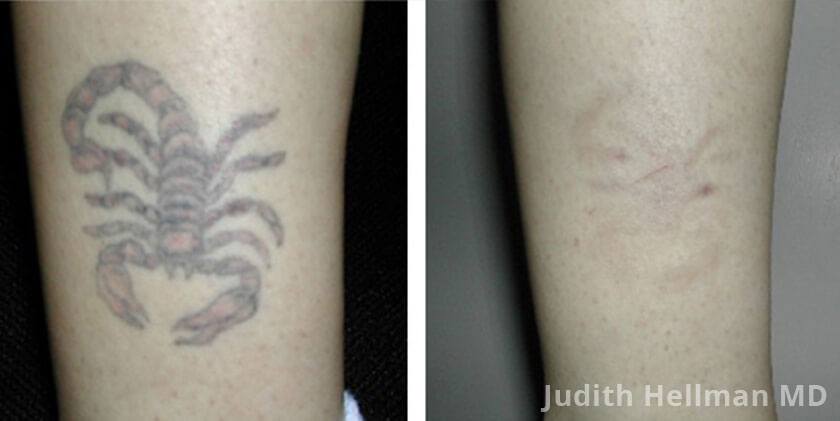Contact Us Today
Q: How does laser tattoo removal work?
During your treatment, the laser will be calibrated to target the exact colors found in your tattoo. Tattoo pigment sits deep within the skin inside of macrophages, the cells that engulf the pigment and remain in the area of the tattoo. The laser targets the pigment contained in these cells and breaks them apart, allowing your body to clear away the fragments over the next several weeks.
Q: Can any tattoo be removed by laser treatment?
All tattoos will respond to laser treatment, but some will respond better than others. Certain colors can be removed more easily than others. The type of tattoo (for example amateur vs. professional) and the age of the tattoo will also dictate how easily it can be removed. Certain lasers are better suited to remove particular tattoo types and colors.
Q: How many treatments are needed to remove a tattoo?
The number of treatments required to eliminate a tattoo will depend upon the color(s) in the tattoo, the age of the tattoo, whether it was done by a professional or an amateur tattoo artist, and the size of the tattoo. In general, tattoos typically require between 6 and 12 treatment sessions to completely or nearly completely fade out (in some cases, the tattoo may never be completely eliminated). The exact number of treatments will vary from person to person.
Q: Which colors are most easily targeted for removal?
Dark blue and black tattoo pigments respond best to laser treatments. These tend to either completely disappear or leave only very minimal marks.
Q: How can tattoos that contain red, green, yellow, and orange colors be removed?
Fortunately, advances in laser technology provide a solution to removing red, green, yellow, and orange pigments from the skin. The Naturalase QS laser uses the most advanced technology, so all of these colors can be effectively treated with just one laser. Older laser technologies were not able to treat all tattoo colors at one time. Even colors that are a mixture of several other colors tend to respond well to treatment with the Naturalase QS.
Q: How is the Naturalase QS superior to other laser tattoo removal systems?
The Naturalase QS utilizes sophisticated technology that combines large spot sizes and flat top beam technology. The result is a laser that utilizes significantly higher energy levels at safer settings and with a faster delivery due to the larger spot size. This results in shorter treatment and recovery times. The laser also offers better protection to the top layer of the skin, yet allows for deep penetration of the laser beam into the skin. This is quite different from other lasers that use small spot sizes with high energy, which may result in scarring and skin pigmentation changes.
Q: Are the treatments painful?
The sensation of pain varies from person to person, but most patients report that the pain associated with tattoo removal is comparable to the pain felt when receiving the tattoo. For patients who are particularly sensitive, we offer a topical anesthetic numbing cream to ensure comfort during treatment.
Contact Us Today
At our office, Only Board Certified Dermatologists See Patients & Perform Treatments
Q: What happens to the skin after each treatment?
After the session, the treated area will appear greyish in color, and then red. At times, the skin may crust over and form a scab. Over the next few weeks, the skin will heal and the body will naturally eliminate the pigment fragments. As the skin heals, the tattoo should appear lighter.
Q: How long should I wait between treatments?
We recommend undergoing treatment no more frequently than every 4 to 6 weeks. This gives the body enough time to eliminate the pigmentation fragments and for the skin to heal before the next treatment. This time frame provides the safest results and the least likelihood of scarring or skin pigmentation changes.
Q: Some practitioners advocate treatments very soon after each other, even on the same day. Is this a good idea?
We don’t recommend undergoing multiple laser treatments in a short time period. Laser treatment causes injury to the skin. If you do not give your skin an adequate time to heal between treatments, the risk of scarring will increase. Tattoo removal is considered successful if the tattoo has been removed and the underlying skin remains undamaged. The double treatments advocated by some practitioners significantly increase the risk of scarring and are not recommended.
FAQ’s
Are the treatments painful?
What happens to the skin after each treatment?
How long should I wait between treatments?
Some practitioners advocate treatments very soon after each other, even on the same day. Is this a good idea?
Written by Dr. Hellman on 2/5/2020
Schedule A Consultation
For further assistance regarding any of our procedures,
Call Us Today (212) 751-0577









